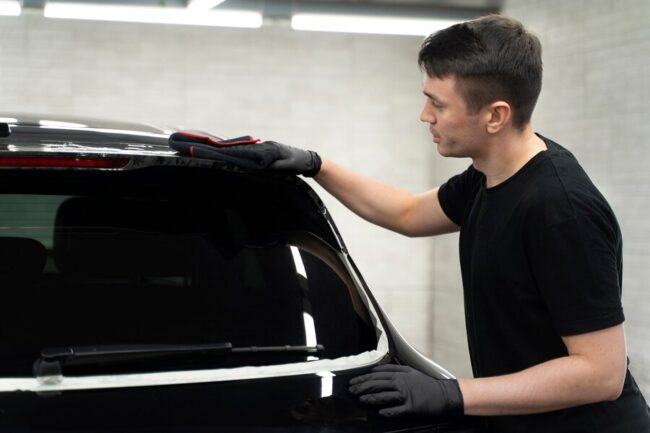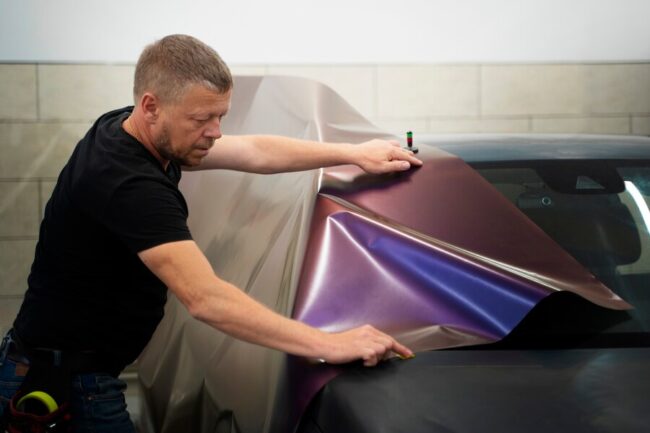Window tinting has evolved from a simple aesthetic addition to a crucial component for enhancing comfort, privacy, and safety in both residential and commercial spaces. While the concept of window tinting is not new, recent advancements have led to the development of multi-layered tinting technology, providing unprecedented benefits.
In this comprehensive guide, we will delve into the science behind multi-layered tinting, exploring its evolution, components, benefits, and factors influencing performance.
Basics of Window Tinting
Window tinting, an application of thin films on glass surfaces, combines aesthetic enhancement with functional benefits by controlling light, heat, and UV radiation. The versatility of this technology is showcased through various film types, each tailored to specific needs:
- Reflective Films: Provide high privacy.
- Ceramic Films: Prioritize heat reduction without compromising visibility.
Common materials in window tinting include:
- Polyester Films: Used as a base material.
- Metals (e.g., Aluminum): Infused for reflective properties.
- Dyed Substances: Absorb solar energy for enhanced efficiency.
This nuanced understanding empowers individuals to choose personalized solutions that align with their preferences, contributing to improved comfort and energy efficiency in their spaces.
 Evolution of Tinting Technology
Evolution of Tinting Technology
The evolution of tinting technology traces back to its historical roots, where window tinting initially emerged as a luxury automotive accessory. Over the years, technological advancements have propelled tinting from a niche application to a ubiquitous feature in the residential, commercial, and automotive sectors. The industry has continually sought innovative solutions to address diverse needs, from the early days of dyed films to the introduction of metalized and ceramic options.
The pinnacle of this evolution lies in the advent of multi-layered tinting, a cutting-edge development that represents the culmination of years of research and technological refinement. Incorporating multiple layers, each serving a distinct purpose, has elevated tinting performance to unprecedented levels, offering users a comprehensive solution for light control, heat reduction, and UV protection.
The Science Behind Multi-Layered Tinting
- Outer Protective Layer: The outer protective layer is the first line of defense in multi-layered tinting. Composed of durable materials, this layer shields the tint film from environmental elements, preventing scratches, abrasions, and other potential damages. Its resilience ensures the longevity of the tint and preserves its aesthetic appeal over time.
- Adhesive Layer: Beneath the protective layer lies the adhesive layer, a crucial component responsible for adequately attaching the tint to the glass surface. This layer ensures a strong and secure bond, preventing peeling or bubbling over time. The adhesive’s quality directly influences the tint’s effectiveness and lifespan.
- Film Layer with Metallic Particles: The core of multi-layered tinting resides in the film layer, which is infused with metallic particles. These particles contribute to the tint’s ability to control light, heat, and UV radiation. The composition and arrangement of these metallic elements determine the specific properties of the tint, such as heat reduction, glare reduction, and UV protection.
- Inner Adhesive Layer: Similar to the outer adhesive layer, the inner adhesive layer provides additional support from the opposite side of the film. This dual-adhesive structure ensures a secure fit to the glass, minimizing the risk of distortion or deterioration. It reinforces the overall stability of the tint, enhancing its durability.
- Inner Protective Layer: The innermost layer is an additional protective barrier, safeguarding the interior side of the tinted glass. It helps prevent damage from cleaning, handling, or accidental contact. The inner protective layer plays a crucial role in maintaining the visual clarity and effectiveness of the tint.
Interaction of Layers for Optimal Performance
The synergy between these layers is pivotal for the optimal performance of multi-layered tinting. The outer protective layer shields against external threats, ensuring the integrity of the underlying layers. The outer and inner adhesive layers create a secure bond between the glass and the tint film, minimizing the risk of peeling or distortion.
The film layer, with its metallic particles, acts as the primary functional component. This layer is responsible for controlling light and heat, allowing for customized tinting effects. The interaction between the adhesive layers and the film layer ensures a seamless and effective integration, providing a balanced combination of durability and performance.
Role of Metallic Particles in Enhancing Tinting Effects
The metallic particles embedded in the film layer contribute significantly to the advanced properties of multi-layered tinting. These particles are strategically designed to filter and selectively block specific wavelengths of light. By doing so, they enhance the tint’s ability to:
- Control Heat: Metallic particles reflect and absorb solar energy, reducing the heat transmitted through the glass.
- Reduce Glare: Glare from direct sunlight or artificial lighting is diminished as metallic particles selectively filter and scatter light.
- Protect Against UV Radiation: The metallic composition blocks UV radiation effectively, preventing harm to occupants and interior furnishings.
 Benefits of Multi-Layered Tinting
Benefits of Multi-Layered Tinting
Multi-layered tinting offers many advantages, making it a superior choice for residential and commercial applications.
Heat Reduction and Insulation:
One of the primary benefits of multi-layered tinting is its exceptional heat reduction and insulation properties. The film layer, enriched with metallic particles, acts as a barrier to solar heat, effectively lowering interior temperatures. This creates a more comfortable living or working environment and reduces reliance on air conditioning systems, contributing to energy efficiency.
UV Radiation Protection:
Including metallic particles in the tint film protects against harmful UV radiation. These particles act as a shield, blocking a significant percentage of ultraviolet rays from entering the interior space. This not only safeguards occupants from potential health risks associated with prolonged UV exposure but also prevents fading and damage to furniture, flooring, and other interior elements.
Glare Reduction:
Multi-layered tinting effectively minimizes glare caused by direct sunlight or harsh artificial lighting. The film layer’s ability to selectively filter and scatter light reduces eye strain and enhances visual comfort. This is particularly beneficial in spaces with large windows or areas exposed to intense sunlight, where glare can impede productivity and hinder a comfortable living environment.
Enhanced Privacy and Security:
The multi-layered structure of tinting contributes to enhanced privacy and security. By limiting the visibility into the interior, occupants enjoy a greater sense of privacy without compromising natural light. Additionally, the durable adhesive layers and protective elements reinforce the glass, acting as a deterrent against break-ins and improving overall security measures.
Factors Influencing Tinting Performance
Several critical factors come into play when considering the performance of multi-layered tinting. Each element contributes to the overall effectiveness of the tint, impacting aspects such as heat reduction, UV protection, and glare reduction.
- Types of Metallic Particles Used: The choice of metallic particles embedded in the film layer significantly influences the tinting performance. Different metals have varying properties, affecting how effectively the tint can block heat and UV radiation.
- The thickness of the Film: The thickness of the tint film is a crucial factor in determining its insulation capabilities. Thicker films generally provide better heat reduction and enhanced durability, contributing to the overall performance and longevity of the tint.
- Quality of Adhesives: The adhesive layer in multi-layered tinting is responsible for the film’s proper bonding to the glass surface. High-quality adhesives ensure a secure and long-lasting bond, preventing issues such as peeling or bubbling that may compromise the tint’s performance over time.
- Professional Installation vs. DIY Kits: The skill and expertise involved in the installation process play a significant role in the tinting performance. Professional installation ensures the film is applied seamlessly, avoiding common pitfalls like air bubbles and misalignment. While DIY kits are available, the lack of experience in the application can lead to suboptimal results, affecting both the appearance and functionality of the tint.
Considerations When Choosing Multi-Layered Tinting
Several crucial considerations should guide your decision-making process when opting for multi-layered tinting.
Local Tinting Regulations:
Adhering to local tinting regulations is paramount. Different regions have specific laws governing the darkness levels allowed for window tinting. Ensure that your chosen tint complies with these regulations to avoid legal complications and ensure a hassle-free experience.
Desired Level of Tint Darkness:
Personal preference plays a significant role in selecting the right tint of darkness. Consider how dark you want the tint to be and how it aligns with your aesthetic preferences. Additionally, remember that darker tints often provide more heat and glare reduction but may impact visibility.
Specific Needs for Heat or Glare Reduction:
Identifying your specific needs for heat or glare reduction is essential. Multi-layered tints offer varying degrees of thermal insulation and glare reduction. In a hot climate, prioritizing heat reduction might be crucial. Similarly, those sensitive to glare may prioritize tints with enhanced glare-reduction properties.
Budget Considerations:
Budget constraints are a practical aspect of any decision. While multi-layered tints offer advanced features, balancing these benefits with your budget is essential. Evaluate different products, considering their features and costs, and choose a tint that aligns with your financial considerations while still meeting your requirements. Remember that investing in quality tinting can offer long-term benefits in terms of durability and performance.
Maintenance and Care Tips
To extend the life and preserve the performance of multi-layered tinting, follow these essential care tips:
- Use a mild, non-abrasive solution and a soft microfiber cloth for regular cleaning. Avoid harsh chemicals that may damage the protective layer, and wipe gently to prevent streaks.
- Exercise caution during cleaning and daily use to prevent scratches. Be mindful of sharp objects, and refrain from using excessive pressure. Take care when loading and unloading to avoid accidental damage.
- Periodic professional maintenance ensures sustained effectiveness. Experts can assess the tint’s condition, address issues, and apply specialized treatments for enhanced durability and UV resistance. This proactive approach maximizes the tint’s lifespan and performance.
In conclusion, the science behind multi-layered tinting is a fascinating journey into advanced technology. With this knowledge, consumers can make informed decisions when choosing window tinting options, ensuring a comfortable and efficient living or working environment. As window tinting technology continues to evolve, understanding the layers that make it all possible will undoubtedly become even more crucial in the years to come.




